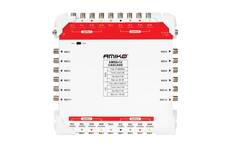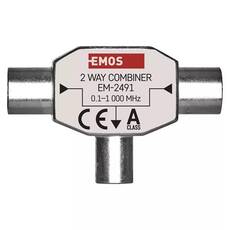Antenna Accessory
- further categoriesAntenna accessories are an essential part of any antenna system, helping to enhance its performance, increase its functionality, and protect it from damage. From antenna rods and radiators to mounting brackets, there are many types of antenna accessories available to improve the functionality and performance of your antenna system.
Antenna rod and radiator
The antenna rod or radiator is the main element of the antenna, responsible for receiving or transmitting radio waves. It is usually made of metal, such as copper or aluminum, and comes in various shapes and sizes, depending on the antenna's design. The length and diameter of the rod determine the frequency it can receive or transmit, making it a critical part of the antenna system.
Magnet mount
One of the most popular antenna accessories is the magnetic base. The magnetic base provides a stable and secure attachment for the antenna, especially when installed on a metal surface. It is easy to install and remove, making it a convenient accessory for mobile antennas. We also offer a replaceable rubber cover for the magnetic base, which needs to be replaced from time to time.
Drillable antenna base
Another type of antenna base is the drillable antenna base. As the name suggests, this type of base can be drilled into a surface, providing a more permanent and stable mounting for the antenna. It is commonly used for outdoor antennas and can withstand harsh weather conditions.
Antenna mounting bracket
Antenna mounting brackets are another essential accessory used to attach the antenna to a structure or mast. They come in various sizes and shapes, depending on the antenna's design and the mounting surface. The bracket provides a secure and stable mounting for the antenna, preventing it from falling or moving due to wind or other environmental factors.
Antenna mast
The antenna mast and mounting bracket work hand in hand to provide a sturdy and secure foundation for the antenna. The mast is a tall structure that supports the antenna and is usually installed on the roof or a tall pole. The mounting bracket attaches the antenna to the mast, providing a stable and secure connection.
Antenna switch and coax switch
Antenna switches and coax switches are accessories used to switch between multiple antennas or devices. They allow you to connect multiple antennas to a single radio or switch between different radios using the same antenna. The coax switch allows you to switch between multiple coaxial cables.
SWR meter and antenna tuner
The SWR meter and antenna tuner are essential accessories used to adjust the antenna's performance. The SWR meter measures the antenna's standing wave ratio, while the antenna tuner helps to match the antenna's impedance to the transmitter's output, improving its efficiency and performance.
Antenna surge suppressor
The antenna lightning protector is an accessory used to protect the two-way radio device from lightning strikes. It provides a safe path for the electrical current to dissipate, preventing damage to the antenna and the equipment connected to it.
Grounding clamp
The earthing clamp for coax antenna cable is an essential accessory used to ground the coaxial cable, providing a safe path for electrical currents to dissipate. It is especially important when using outdoor antennas, as it helps to prevent electrical shock and other hazards.
Antenna rotator
The antenna rotator and hoist are accessories used to adjust the antenna's direction and elevation. The rotator allows you to rotate the antenna, while the hoist helps to lift it to a higher position, improving its range and performance.
Antenan dummy load
The antenna dummy load is an accessory used in place of an antenna as a termination for an RF line. Typically used for measurements.
Wifi antenna splitter and coupler
The WiFi antenna splitter and coupler are accessories used to split the signal from a single WiFi or TV antenna into multiple devices. They allow you to connect multiple devices to a single antenna, improving the signal strength and quality.
Wing bolt
The wing bolt is an essential accessory used to attach the antenna to the mast or mounting bracket securely. It is easy to install and remove, making it a convenient accessory for outdoor antennas.
Antenna meter
The antenna adjusting instrument is used to adjust the antenna's position and direction, ensuring optimal performance and reception. The antenna adjusting instrument is a handy tool for outdoor antennas, which can be affected by environmental factors such as wind, rain, and temperature.
TV antenna splitter
Another popular accessory for TV antennas is the TV antenna splitter. The splitter allows you to connect multiple televisions to a single antenna, making it a convenient option for homes with more than one TV. The TV antenna splitter is a cost-effective way to improve reception and reduce the need for additional antennas.
TV antenna amplifier
The TV antenna amplifier is another popular accessory used to improve signal strength and reception. The amplifier is designed to increase the power of the TV signal, making it a more reliable option for remote or weak signal areas. The TV antenna amplifier is a useful accessory for those who live in rural areas or regions with weak TV signals.
Satellite receiver LNB head
For those who use satellite TV, the satellite receiver LNB head is an essential accessory used to receive the signal from the satellite. The LNB head is installed at the end of the satellite dish's arm, where it collects and amplifies the signal, which is then transmitted to the satellite receiver. The LNB head is critical for receiving a clear and stable signal, making it an essential accessory for satellite TV systems.
In conclusion, antenna accessories are essential components of any antenna system, used to enhance performance, improve reception, and protect the equipment from damage. Whether you are using a TV antenna or a satellite TV system, there are many accessories available to help you get the best possible signal and reception. From antenna adjusting instruments to LNB heads, these accessories are essential for achieving optimal performance and reliability from your antenna system. So, whether you're a professional installer or a DIY enthusiast, make sure to invest in the right antenna accessories to get the most out of your system. You can find it all here!



















